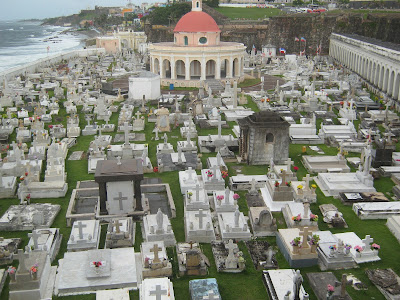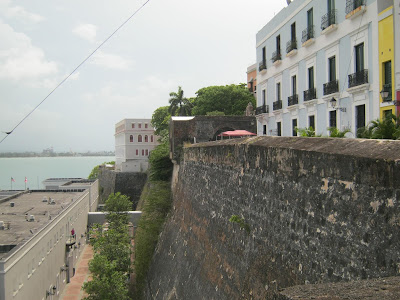June 2 2017 it’s been 11 months on
the boat and also it’s the start of hurricane season
We moved
from Mayagues to Puerto Real on Tuesday.
After checking in it
looked like a great day to sail 10 mile to Puerto Real. Moving around Puerto
Rico will be a short hops from port to port. We are still on the west end of
the island and we are protected from the tropical easterly winds. The south
coast is 15 miles away so when we move east up the south coast it will have to
be early morning and get back into shore by 10 am before the winds come up. So
we took up anchor in Maygues preparing for a short 10 mile sail in great
weather. About a half hour after leaving we noticed dark clouds moving close to
our location. It was hard to tell if it would come close or not. Then all of a
sudden I had an over heat alarm so I had to turn off our engine. I was just
far enough from shore to sail any way. This was no problem as long as the dark
clouds were not coming our way. I had the front sail out and the wind picked up
as the storm got closer. I didn’t like this because there was lightning in
these clouds. The wind changed from 10
knots to 35 in about 10 minutes so I had to move fast to shorten the sail. So
now we had to sail into our slip, Ben from Wind Machine suggested he push me in
with his dinghy and that would work. As we were getting into the bay we
were protected from the wind and we arrived in out slip safely. Later Abby that
was left on Wind Machine noticed a water spout, so there was some bad weather
around. So it was back to fixing the boat again but the problem wasn't too bad. I found a piece of
the old impeller stuck in the 90 degree turn in the pump and that was restricting
the water flow. While we were here I decided to get my fuel polished so the
engine wouldn’t stop on me anymore. It’s
been 2 days of fixing and now we are waiting for a new Visa card to be
delivered here to us. We may have some time to look around. We wanted to move
on to Ponce but now we have to wait. Here's a few pictures from around the marina.
Notice the clouds. It rains almost every day here. We have been told that the northern part of Puerto Rico gets around 200 inches of rain a year and some of the south part is like a desert and only gets a few inches of rain a year
Great little restaurant.
This is the street out front of the Marina
And know it's time again for:
So Here's Interesting Tidbits SHIT for short.
When you talk to the locals it is really interesting what you can learn. We talked with the marina electrical engineer here at the marina and he told us that this years hurricane season will be a quiet one. He told us that he has seen the sand from the Sahara in the air?? So here's some info about that....
Saharan Dust: How Does This Impact The Atlantic Storms?
The Saharan Air Layer, or known more commonly as " Saharan Dust"
it is a layer of tiny aerosols like sand, dirt, and dust that occasionally push from east to west across the tropical Atlantic Ocean during hurricane season. These aerosols originate over the very hot deserts of Africa, like the Saharan Desert, and sometimes get picked up by African Easterly Waves which push westward from Africa into the Atlantic Ocean.
The Saharan Air Layer is a well-mixed dry pocket of air that usually resides between 5,000 and 15,000 feet above sea level. Since one of the key ingredients for tropical cyclone development is a deep feed of moisture, Saharan Dust often acts to inhibit tropical development. Research suggests that there are three primary reasons Saharan Dust has a negative impact on tropical development.
1) A surge in the mid-level African Easterly Jet increases the vertical wind shear
2) The inclusion, or drawing in, of dry air into the tropical system
3) An enhanced trade wind inversion which acts to stabilize the atmosphere. A stable atmosphere will make it more difficult for deep convection to develop.
Once a pocket of Saharan Dust begins moving westward over the Atlantic Ocean, it is relatively easy to track by using certain infrared satellite products. The algorithm in some infrared products is sensitive to dry, dusty air and therefore can be tracked when pockets of this kind of air move from place to place.
Many factors go into forecasting the track and strength of a tropical system. Knowing whether or not a tropical cyclone will have Saharan Dust in its vicinity is one factor that can determine the cyclones intensity.
Interesting S.H.I.T. I hope it is true.....
BIOLUMINESCENCE
Since we left the Turks and Caicos we are seeing more and more bioluminescence in the water. When we sail at night we can see splashes from our wake that light up. It looks like hundreds of little fireflies in the water. We are still seeing this in the waters of Puerto Rico. Here's some information about bioluminescence.
Bioluminescence is the production and emission of light by a living organism. It is a form of chemiluminescence. Bioluminescence occurs widely in marine vertebrates and invertebrates, as well as some fungi, microorganisms including some bioluminescent bacteria and terrestrial invertebrates such as fireflies.
Most bioluminescent reactions involve luciferin and luciferase. Some reactions, however do not involve an enzyme (luciferase) These reactions involve a chemical called photoprotein. Photoprotein combine with luciferins and oxygen, but need another agent often an ion of the element calcium to produce light.
All bioluminescence comes from energy released from a chemical reaction. This is very different from other sources of light, such as from the sun or a light bulb where energy comes from heat. In a luminescent reaction, two types of chemicals, called luciferin and luciferase combine together.
Luminescent bacteria that produce light have a symbolic relationship within other organisms. Bioluminescence is a type of chemiluminescence due to the production of light by a chemical reation. There are two molecules that are produced by the organisms luciferin which is a pigment and luciferase which is an enzyme.
I don't know what that means but its interesting S.H.I.T.!!












































